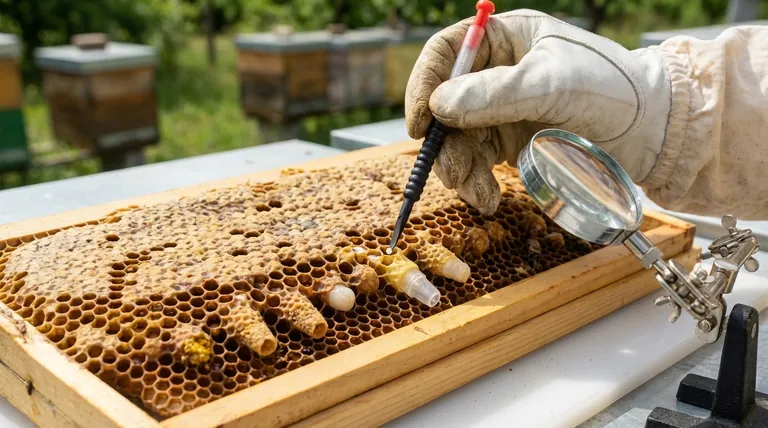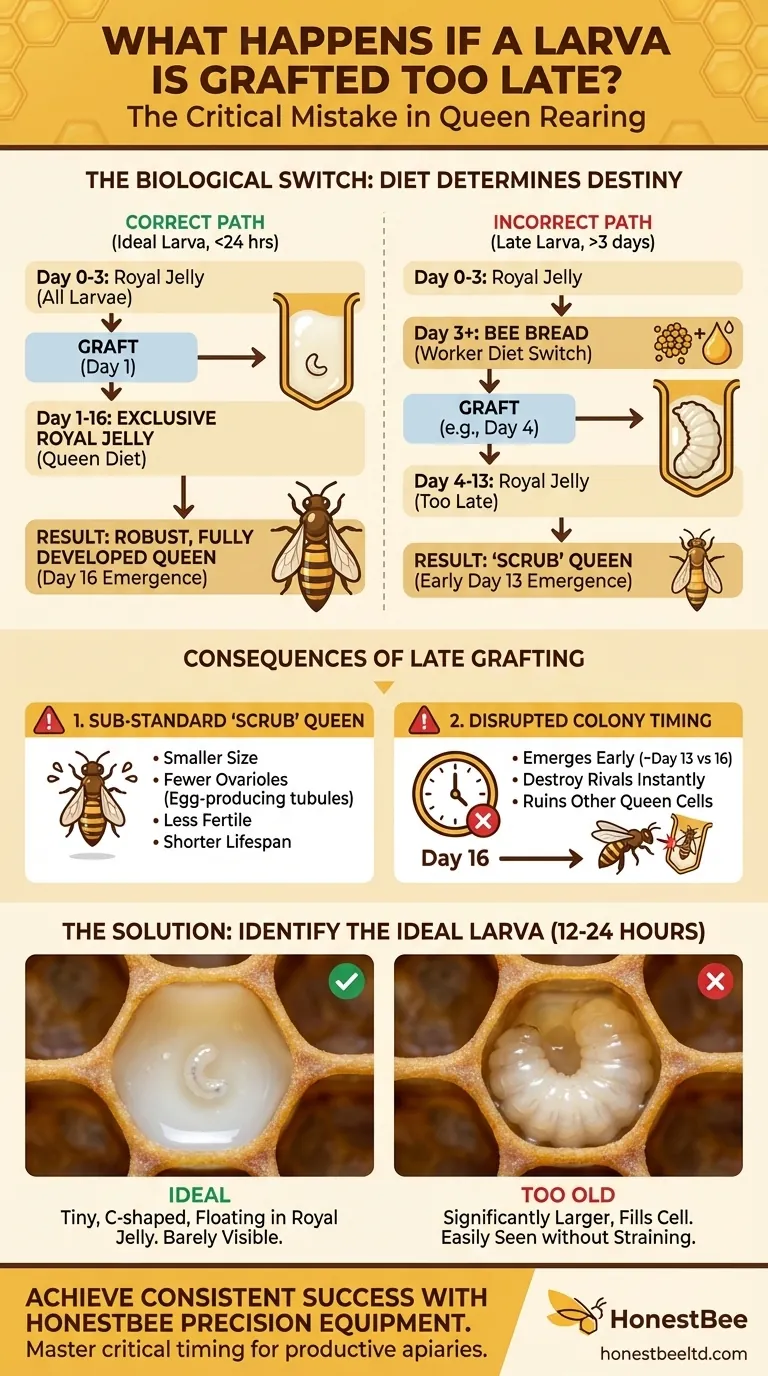Grafting a larva that is too old is one of the most common and critical mistakes in queen rearing, leading to a poorly developed queen and disrupting the precise timing required for success. When a larva older than approximately three days is chosen, it has already missed a crucial developmental window, resulting in a "scrub" queen that is smaller, less fertile, and has a shorter lifespan.
The entire success of queen rearing hinges on a biological switch. A larva becomes a queen only if it is fed an exclusive diet of royal jelly; grafting an older larva means you have selected one that has already been weaned onto a lesser diet, permanently limiting its potential.

The Biology of Queen Development
To understand why late grafting is so detrimental, you must first understand the fundamental difference between a worker bee and a queen. It is not genetics; it is diet.
The Critical Role of Royal Jelly
All newly hatched female larvae are fed royal jelly by nurse bees for the first three days of their life. This protein-rich substance is the key to queen development.
For a larva to become a queen, this diet of pure royal jelly must continue exclusively throughout its entire larval stage.
The Worker Bee Dietary Switch
For larvae destined to be workers, nurse bees change their diet after day three. They begin feeding the larva a mixture of pollen and honey known as "bee bread."
This dietary change triggers the development of a worker bee, suppressing the full development of her reproductive organs.
Why Grafting Age Matters
When you graft, you are signaling to the colony to raise that larva as a queen. The nurse bees will oblige and feed it royal jelly.
However, if you graft a larva that is already four days old, it has already spent a day being fed bee bread. That period of "improper" nutrition cannot be undone. It has missed the window for the uninterrupted royal jelly diet required to become a robust, fully developed queen.
The Consequences of Late Grafting
The impact of choosing an older larva is twofold, affecting both the quality of the resulting queen and the management of your entire queen-rearing operation.
A Sub-Standard or 'Scrub' Queen
A queen raised from an older larva will be physically inferior. She is often smaller and may be mistaken for a large worker.
More importantly, her internal development is compromised. She will have fewer ovarioles (the egg-producing tubules in her ovaries), making her a less prolific layer. This directly impacts your colony's population, health, and productivity.
Disrupted Colony Timing
The bee development timeline is precise. A queen emerges around 16 days after the egg is laid.
If you graft a 4-day-old larva (instead of a 1-day-old one), you have unknowingly moved the schedule up by three days. Your new queen will emerge around day 13, not day 16.
This can be catastrophic. An early-emerging virgin queen's first instinct is to kill her rivals. She will immediately seek out and destroy all the other queen cells you have prepared before you have a chance to separate them, ruining your efforts.
Identifying the Ideal Larva: The Key to Success
Avoiding this problem requires knowing how to spot a larva of the perfect age. The ideal window is between 12 and 24 hours after hatching.
The Optimal Visual Cues
Look for the smallest larvae you can see. An ideal larva will be barely visible to the naked eye, shaped like a tiny "C," and will appear to be floating in a milky white pool of royal jelly.
What to Avoid
As larvae age, they grow quickly. A 3-day-old larva will be significantly larger and will nearly fill the entire bottom of the cell. Any larva this large is already too old for grafting. If you can easily see the larva without straining, it is likely too old.
Making the Right Choice for Your Goal
Your approach to larval selection directly determines your outcome. Precision is not optional; it is the foundation of the entire process.
- If your primary focus is raising high-quality, productive queens: You must exclusively graft larvae that are 24 hours old or younger to ensure they receive the full, uninterrupted diet of royal jelly.
- If your primary focus is managing your queen-rearing schedule: Grafting larvae of a consistent, known young age is the only way to accurately predict emergence dates and prevent early virgins from destroying your other cells.
Mastering the art of selecting the right larva is the single most important factor in successful queen rearing.
Summary Table:
| Consequence of Late Grafting | Impact on the Queen & Colony |
|---|---|
| Sub-Standard ('Scrub') Queen | Smaller size, fewer ovarioles, less fertile, shorter lifespan. |
| Disrupted Emergence Timing | Queen emerges early (~day 13), may destroy other queen cells. |
| Missed Critical Development | Larva has already switched to bee bread, limiting royal jelly benefits. |
Raise Superior Queens with Precision Equipment from HONESTBEE
Mastering the critical timing of larval grafting is essential for productive apiaries and successful distributors. Equip your operation with the reliable, high-quality beekeeping supplies needed for consistent success.
At HONESTBEE, we supply commercial apiaries and beekeeping equipment distributors with the wholesale-focused tools to excel in queen rearing and overall hive management.
Contact our experts today to discuss how our equipment can help you achieve your queen-rearing goals.
Visual Guide

Related Products
- Black 2 Pack Beekeeper Queen Grafting Tool for Bee Queen Larva Transferring Needle
- Stainless Steel Queen Grafting Tool for Beekeeping and Bee Queen Grafting
- Nicot Queen Rearing Kit for Beekeeping and Grafting in Nicot System
- Plastic Chinese Queen Grafting Tool for Bee Queen Rearing
- No Grafting Queen Rearing Kit: System for Royal Jelly Production and Queen Rearing
People Also Ask
- What is the grafting method of queen rearing? Master Controlled Queen Production for Your Apiary
- What is the purpose of a queen grafting tool in beekeeping? Master Larva Transfer for Selective Breeding
- What conditions should be avoided during grafting? Protect Your Queen Cells from Common Pitfalls
- What is the grafting method for raising queen bees? Master Genetic Control for Your Apiary
- What tools are used to transfer larvae into queen cell cups? A Guide to Grafting Tools for Queen Rearing



















